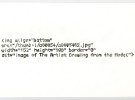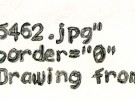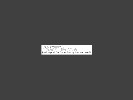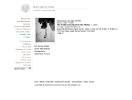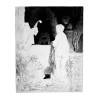The Artist Drawing from the, 2004
The Artist Drawing from the Model (HTML image tag for an unfinished work)
Presented in the group exhibit “Shared” – organized by Mark Power
A Graphite drawing on paper, of the invisible HTML image placement tag for a jpeg of the following drawing: “Rembrandt van Rijn, Dutch, 1606 – 1669, The Artist Drawing from the Model, c. 1639, Â etching, drypoint and burin, sheet: 23.4 x 18.2 cm (9 3/16 x 7 3/16 in.), Â Print Purchase Fund (Rosenwald Collection), 1968.4.1, from “the collection” directory of the National Gallery of Art, Washington D.C.’s web site.
Original URL: http://www.nga.gov/cgi-bin/pinfo?Object=50563+0+none
HTML Code Snippet:
<img align=”bottom”
src=”/thumb-l/a00054/a0005462.jpg”
width=”152″ height=”190″ border=”0″
alt=”image of The Artist Drawing from the Model”>
Project Description:
It is a kind of take on the Rembrandt van Rijn work and the process of art making, but it is also intended to explore some of the issues of what it means to be an artist today.
The work references the unfinished etching by Rembrandt and the invisible information tags or code which instruct web browser software how to draw web pages. The Webpage itself is unfinished until the image associated with the tag is added, completing the composition.
With his etching, Rembrandt was in the process of creating a kind of quintessential popular image of the “artist”, and the artist in the image could be Rembrandt himself, as the working figure bears some resemblance to his other self portraits. The artist is drawing the model while surrounded by the paraphernalia of the studio, and immediately behind him, a large unpainted canvas rests on its easel.
There are other references as well. In the right background is a sculpted bust covered over with a cloth. The model stands on a low platform while holding some fabric and a palm frond. Common enough props, but also visual suggestions that, even though the artist is drawing rather than sculpting, Rembrandt, the history painter, is working with the idea of Pygmalion.
It is Pygmalion’s story, in a round about way, that leads to the inspiration for the 2004 artwork. Pygmalion, legendary figure of Cyprus, is referenced in Ovid’s Metamorphoses,book 10, in which he is a sculptor who falls in love with a female statue he carved out of ivory. According to Ovid, after seeing the Propoetides prostituting themselves, Pygmalion is ‘not interested in women’, but his statue is so realistic that he falls in love with it. He offers the statue presents and eventually prays to Venus who takes pity on him and brings the statue to life.
The story of living statues has parallels with Daedalus, who was said to use quicksilver to make his statues speak, and Hephaestus, who created automata for his workshop, and even Pandora, and the Golem who were both said to be created from clay. Though this is myth, it is inspired by actual fact.
The eastern Mediterranean islands were known in ancient times for their astounding mechanical engineering creations, including what today might be referred to as animatrons or mechanical people. Pindar the Greek poet notes in describing Rhodes: “The animated figures stand adorning every public street and seem to breathe in stone, or move their marble feet.” The Antikythera mechanism, the first known mechanical computer, designed to calculate astronomical positions, was discovered in a wreck off the Greek island of Antikythera in 1901, and is dated to about 150–100 BC.
So in the story of Pygmalion the idea of conceptual or aesthetic creation, engineering and computing, and religious/magical substantiation is all tied together, and comes from the commonplace trope of sculptures so lifelike they are real.
In contemporary society individuation of tasks has continued in a branching process for a long time, with the engineer and the artist seemingly having parted ways. Yet recent technological innovations such as desktop publishing and laptop video production are allowing specializations to recombine, and allowing non specialists to take on tasks previously accessible only to experts.
Further, new technologies are regularly picked up by contemporary artists to create work with. Recent developments in computer code have even provoked engineers and programers to question whether what they are doing can be said to constitute an art form in itself. Â All kinds of media are being used and explored and exploited as art. Thus this snippet of computer code works for a variety of reasons to make an analogy with Rembrandt’s work about artists.
Rembrandt is known for his amazing ability to convey feeling through physical gesture. His work is about an artist drawing, and so I also try my hand at physical gesture in graphite. The text in the 2004 artwork has not been written, but has been delineated by sketching the outlines of the forms of letters and then filling them in. Van Rijn’s work has a meta level to it, with the story of drawing contained within the actual drawing. Likewise the drawing of computer code functions as a meta level for the jpeg image of drawing it refers to.
The copied code for the jpeg from National Gallery of Art site becomes a kind of conceit. The code is about location, position and relationship to surroundings, as well as the fact that there is no border or frame to be drawn around the image. All this loosely relates to the artists surroundings and the unframed canvas featured in Rembrandt’s background. The word “thumb” becomes a synecdoche referring to the artist’s drawing hand. Lastly, the female figure Galatea (“she who is milk-white”), appears in countless paintings of the Pygmalion myth shown from behind, just as she does in Rembrandt’s work. The code referring to image alignment (img align=”bottom”) thus functions as a joking reference to the glowing white ass that becomes the central image in these male dominated fantasies, and equates with the structuring of the viewer’s gaze to align on Galatea’s Bottom.
It has been said that for Rembrandt etching a plate was a process of exploration, not a straightforward transcription. In his work he is considering details for a kind of portrait of an artist. Yet it is not a portrait of what the artist looks like, but rather what his circumstances are, and what drives him.
The drawing of a bit of text with pencil on paper seems hardly a finished work, and the code itself without the final jpeg image inserted would constitute an unfinished web page. In The Artist Drawing from the Model (HTML image tag for an unfinished work,) the project of what it means to be an artist is being worked, and yet it remains unresolved.
